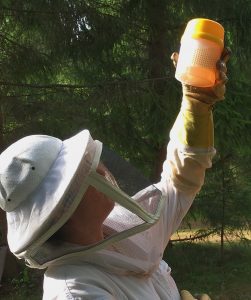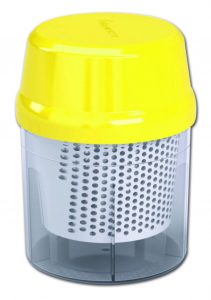The summer has been filled with work despite bad weather. However, the queen breeding has worked well. But despite the cooperation with Radim, it has taken a lot of time. Demand for queens has increased. It has meant more work. I hope queen buyers are aware of how much time it takes to produce queens.
The blogs have been suffering. I havn’t had time to share experiences as I had wanted, but now the bees are soon ready for winter, which should mean more time at the computer.
The value of measuring the Varroa level
Patrick Sellman called me yesterday September 3 and shared experiences from a course he had had for beginners that day. He has held several courses this summer on managing top bar hives (TBH). There measuring the Varroa level with alcohol wash with the Bee Shaker is an important part. Treating with Thymol against varroa when needed is also what he teaches.
This course was held in an apiary with 5 TBH. Most of these had been made with bees from frame hives treated against Varroa the previous year. One was a split from a TBH, which was also treated the previous year. The apiary is located almost 3km from other bees
Not a single mite appeared in the shaking jar from any of the colonies! The Bee Shaker has always shown mites in different amounts during all other courses Patrick has held. He took at least 300 bees from each colony from the outer lists. To test the test he took a test of almost 400 bees from one of the inner lists from one of the colonies. Zero mites again. He even tested the alcohol and replaced the alcohol with another type for one of the samples of 300 bees. – no mites. A total of about 2000 bees without any mites.
 Counting mites at the bottom of the Bee Shaker
Counting mites at the bottom of the Bee Shaker
The value of enough distance to other bees
We discussed for the reasons for the lack of mites. Only one elgon bees, from Thomas Dahl, ie bees selected for Varroersistens a little more than the others. We concluded:
- Sufficiently far from other bees to prevent reinvasion from others’ bees through mainly quiet robbing by your bees during nectar droughts.
- The colonies were small in the beginning with less brood than larger colonies. Less with brood gives less amount of brood hormones that trigger mites to return to new brood cells for reproduction. This means the mites will spend longer time on bees before entering a new brood cell. This results in a slower growth rate for the mites.
- The bees built their combs without wax foundation. They made different cell sizes depending on the place of and distance to the entrance. They arranged their homes without much disturbance from the beekeeper.
- The entrance is usually significantly smaller than in frame hives, easier to defend against bees from other colonies, when they try to sneak in and steal honey.
Due to the alcohol tests, none of these 5 colonies were exposed to unnecessary strains of miticides this year. Next year’s Bee Shaker tests will show when or if Varroa treatment will be needed.
The latest version of the Bee Shaker is Easycheck, which you can read more about here: http://www.veto-pharma.com/varroa-easycheck-contest/
Additional info:
Patrick Sellman have commented om my Swedish blog that actually three colonies had elgon bees from Thomas Dahl. The other two were Buckfasts. This means is a majority of the bees were at least somewhat selected for varroa resistance. Which also means that they contributed at least somewhat in resistance for the Buckfasts as well as bees do drift in an apiary.

Clarify something for me please. Are your bees treatment-free or not. I’m completely uninterested in reading about apiaries using thymol and just want to clear up my blog feed. Thank you.
Some are, some are not. Fewer and fewer are not. And fewer and fewer of the colonies are not. Thus the number of colonies that are treatment free are growing. If you decide to leave, glad you have been my guest Bruce.
Bruce, there are many approaches to treatment free, one is using integrated pest managements, which means the susceptible bees are treated to have bee colonies left to introduce better queens into.
Treatments could be chemical or technical, like culling brood.
The hard bond could mean 100% losses which is not acceptable to some, for example me or Erik.
That said, back to serious work like Erik does it.
Erik,
your topic reminds me of Tom Seeleys publications.
I want to try this kind of beekeeping in future, but still monitor mites and crawlers.
In my area the problem still is, and will be in future, that I´m not isolated.
Worse still, the surrounding hives are multiplied without selection AND treated. This means, they are susceptible to chalk brood and mite disease and lower virus impact thresholds.
The worst case scenario.
So I plan to breed drones from my survivors and flood the area for some time.
With your stock and their descendants I hope to be able to have some survivors which are not treated. My 2 hives out of 13 which are not resistant are treated just now and will be used as nurse colonies for better queens next year.
The 2 hive are placed isolated from the others.
There must be a way for me and my co-workers to have tf stock.
Never give up. 🙂
Sibylle
Erik,
are you sure of this:
> Less with brood gives less amount of brood hormones that trigger mites to return to new brood cells for reproduction. This means the mites will spend longer time on bees before entering a new brood cell. This results in a slower growth rate for the mites.<
Can you explain more? Are mites which spend longer times on bees not as prolific?
Monitoring with the alcohol wash in my eyes gives only realistic counts when done while most of the brood cells are open.
I´m not sure I will be able to do this at the right moment, since I´m not going into the hives all the time.
The mites are like waves, phoretic or in brood cells.
In my hives there is not a balance between open or capped brood.
Sometimes most cells are capped, sometimes open.
With only 10-15 hives one should be able to see the state of the mite infestation on the combs or entrances ( entrances could led you astray because the bees carry away diseased brood) or on the floor boards, counting mite numbers every morning.
Having outyards the alcohol washes are more reliable, but in my eyes only when most of the brood cells are open brood.
What´s your opinion?
Hi Sibylle
You ask:
are you sure of this:
Less with brood gives less amount of brood hormones that trigger mites to return to new brood cells for reproduction. This means the mites will spend longer time on bees before entering a new brood cell. This results in a slower growth rate for the mites.<
Yes, I am. The brood hormone called juvenile hormone is well known to attract varroa mites to enter brood cells (there are also some other things that affect the returning of mites into brood cells). I didn’t find the paper I looked for but found this, in which you find that a bigger amount of brood cells increase the mite return. http://edepot.wur.nl/202208
Can you explain more? Are mites which spend longer times on bees not as prolific?
No that is not a direct conclusion. During broodless periods mites can stay phoretic for several months.
Monitoring with the alcohol wash in my eyes gives only realistic counts when done while most of the brood cells are open.
I´m not sure I will be able to do this at the right moment, since I´m not going into the hives all the time.
The mites are like waves, phoretic or in brood cells.
In my hives there is not a balance between open or capped brood.
Sometimes most cells are capped, sometimes open.
It’s the same for us all. All monitoring are realistic. The question is how to understand them. What you want from monitoring is to get a figure that helps you to make a decision. Scientists agree that alcohol wash is the most reliable method. And gives you a quick answer. My experiences so far confirm this. I will try to share my experiences from this year further on. They confirm the benefit of the method.
No method is perfect, not this either. But you can combine different methods. A good combination is a 0.5 x 0.5 m hard board in front of the entrance. With a quick look you get a first impression of the health of the colony. Is it clean from dead, deformed or crawling bees it’s a very good sign. How the colony develops is another good help to judge the health of it.
The number of alcohol washes in your situation I guess would be three during a season, in spring, middle of the summer and late summer. In spring is a varroa level of 2.5 % a good threshold for taking action. In the middle of summer 3 %. If the late summer measurement is very late when there is no or very little of brood a higher threshold could be used as all mites are phoretic then. During the brood season about 1/3 of the mites are phoretic. It varies and the mites are not perfectly even distributes on the bees, but they are enough even distributed on brood combs and combs close to brood combs. Avoid combs close to the entrance where there are less mites (as it can bee far from the brood).
This link text is most exciting and a very good help in using biotechnical methods as pest managements. Thanks very much, Erik.
Your explanations correlate with my observations.